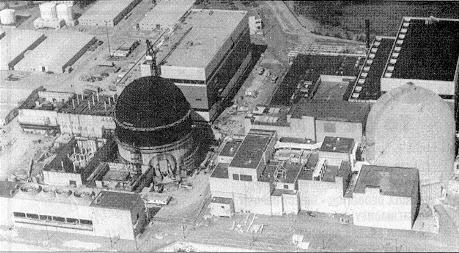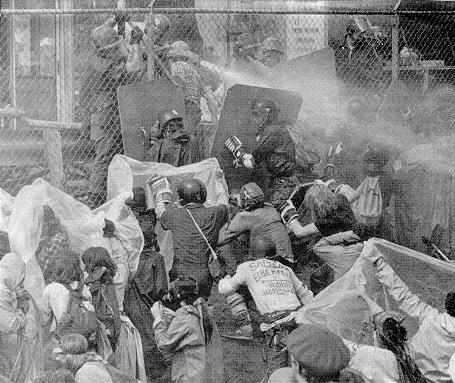September 28, 1999
Nuke Plant Dominated Headlines
By Steve Jusseaume, Staff Writer
While the construction of a nuclear plant and the controversy surrounding proved to be the hottest local story over the last 100 years. It didn't always make the news.
One of the first issues of the Union reported in 1900 that a number of French Canadian families living in a logging camp on the north side of Farm Road in Seabrook suffered through a prolonged blizzard.
The blizzard was, of course, memorable for those who lived through it: Other memorable moments have also helped to shape the town.
The first bridge across the harbor from Seabrook to Hampton was built in 1902. Almost a mile long, it was built of wood and primarily used for trolley traffic, with a toll rate that included home and riders, horse-drawn vehicles, driven cattle, sheep and swine.
In 1910, the population of Seabrook was 1,425. The town’s tax inventory four years later included 106 horses, 81 cows, four neat stock, one sheep, three hogs, 221 fowl . . . and 24 motor vehicles.
In 1916 there were 37 births in Seabrook, 24 marriages and 37 deaths. Licensed peddlers were everywhere. One hundred eighty- nine clam permits were issued in 1915, and a 1917 town report noted that five pool table licenses were issued. Also in that year, the town paid $3.00 for one-half cord of wood from a local man.
Fifty-two men enlisted from Seabrook and served in World War I, and when the war ended, the town raised $175 for a welcome Home Day Celebration in 1919. In response to the increased number of motor vehicles in town, Benjamin Perkins installed gas pumps in front of his restaurant on Lafayette Road, which he had opened In 1920 as "Perkin's Barbecue." Beginning in 1929, cement was poured on Lafayette Road to facilitate auto traffic.
Seven years later, a cement sidewalk was put in at South School. During the depression of the 1930s, road work continued at an increased pace, largely because of the federal program to provide work for the unemployed. During World War II, it was necessary to purchase ration books and coupons to buy sugar, butter, meat, canned foods and gasoline. People in Seabrook, as in other towns, planted "Victory Gardens" while the coast was blacked out throughout the war years so reflected lights from houses and cars would not silhouette passing ships, which might aid German U-Boats off-shore in sinking them.
In total, at least 189 Seabrook men and women served in the war.
In 1945, the state motto "Live Free or Die" was accepted.
Locally, $50 was appropriated to defray expenses of lighting the World War II Soldiers Memorial at Smithtown Square. A year later the town established a park on South Main Street and called it Veteran’s Memorial Park.
In response to 75 fires in the year 1946, the town purchased a new Buffalo "500" fire truck with a built-in Hale pump. Also in 1946, the beach precinct was established. Several town offices were established around the mid-1900s, including the first Seabrook Planning Board. The positions of tax collector and town clerk were combined into one in 1948, and the park commissioners voted as a board in that year.
Ninety-two men and women served during the Korean conflict from 1950 to 1953. Two men, Ananais Janvrin and William N. Eaton, were killed in action.
Firefighting and water availability continued to be a priority in the 1950s. Water is still a town-wide concern today.
The town voted to install a water system in 1954, at a cost of about $720,000, and a fire at Burton Dow’s home was the first one where a hydrant was used. By the end of the year, 700 Seabrook residents got their water through the town system.
In 1965, a town conservation commission was established, and the following year a bicentennial committee was formed to plan the town’s 200th year birthday. The celebration occurred in July 1968, just four months after the first woman selectman was elected, Mrs. Alice Holloway. All the while, the population of the town continued to grow, from less than 3,000 in mid-century to 3,053 in 1970, 5,917 in 1980, 6,691 in 1994 and an estimated 8,500 in 1999. As the Seacoast became more populated as the 20th Century progressed, Seabrook grew. Route 1 provided easy access to the town, and inexpensive land prices drew investors and developers from Massachusetts.
Nuclear Plant Controversy

construction. The plant finally went on-line in the 1980s. [File photo]
One of the most important developments in the history of the town occurred in the late 1960s, when Public Service Company of New Hampshire chose a desolate stretch of land east of Route 1 and near the marshes to build a nuclear power plant.
PSNH announced its intention to build an 860,000-kilowatt plant in Seabrook In December 1968. The plant was expected to be finished in 1974. At the time, Hampton Union reported, "Management of Public Service does not anticipate difficulties in obtaining the necessary licenses and permits for the Seabrook site because it is not near an airbase (as was Newington, its first choice for a site), and condenser cooling water can be discharged directly to deep water in the Atlantic Ocean."
In March 1969, the Seacoast Anti-Pollution League was formed to oppose construction. In February 1971, PSNH announced its intention to build not one but two nuclear reactors, which would generate 2.2 million kilowatts of electricity, to be constructed at a cost of $1 billion.
Despite opposition, PSNH broke ground for construction of the power plant in August 1976, and on May Day 1977, a newly formed organization named the Clamshell Alliance staged a massive protest at which 1,414 people were arrested and charged with civil disobedience.

protests in the late 1970s by those opposed to its construction.
Here, police had to use hoses in an attempt to control the crowd.
[File photo]
In 1979, another protest was met with violence when police used attack dogs, tear gas, and riot sticks to turn away some 2,000 demonstrators.
After years of construction and continued protests, the plant went on-line in the late 1980s and is now in the process of decommissioning, which could occur as early as 2015.
In the past couple decades. Seabrook, and its main thoroughfare, Route 1, has been developed more rapidly than at an other time. The Seabrook Greyhound race track on Route 107 was built in the early 1970s, a Wal-Mart shopping center just south of Route 107 was built in the early 1990s, and in the past several years in past several years many new businesses have been built along Lafayette Road, including an Applebee's restaurant and Sullivan Tire this year. A Staples office supply store is also planned. In addition, a theater/restaurant complex is being proposed for a tract of land behind Wal-Mart.
In the face of rampant development, local officials have recently moved to curb over-extended development and also have begun planning conservation measures which would restrict building along the Route 1 corridor.
